|
WHAT'S THAT 'BUG'?
Most invertebrates on Thásos are inconspicuous and unlikely to be seen by
the casual observer. A few, however, are sufficiently obvious and evidently
different from anything visitors from more northern and western climes may be
used to that they draw attention.
The most striking of these must be the fireflies.
In late May and June luminescent flashes of green light mark the location of
these remarkable beetles as the female ‘calls’ from a vantage point in dry
grassland and the males fly around a few feet above the ground advertising their
presence. In flight, the males emit a bright flash about once a second but the
female’s response is a longer duller glow from a stationary position. The old
pasture at the side of the river next to Hotel Aethria in Thassos Town is a good
place to see them and they are also present on the ridge between the old Fort
and the Temple of Athena (but much harder to see now that the area is floodlit).
The species here is the widespread Mediterranean firefly, Luciola lusitanica
(Coleoptera, Lampyridae), but others may occur.
Another unmistakable invertebrate ‘event’ of summer is the constant song
of the crickets from late afternoon/early
evening onwards. Several species are involved but I suspect that the tree
cricket Oecanthus pelluscens (Orthoptera,
Gryllidae) is one of the main culprits. All of the likely choristers are
ventriloqual and it can be extremely difficult to pinpoint exactly where the
sound is coming from. The noise is made by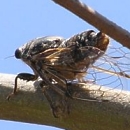 the crickets rubbing their forewings together very
fast over their backs, but cicadas make their shrill song by vibrating membranes
on the side of their bodies. Cicadas
certainly occur on Thásos but so far I have been
unable to determine which species are involved. From mid-summer there is a
seemingly endless cacophony from their perches in lowland scrub and high up on
the branches of conifers. the crickets rubbing their forewings together very
fast over their backs, but cicadas make their shrill song by vibrating membranes
on the side of their bodies. Cicadas
certainly occur on Thásos but so far I have been
unable to determine which species are involved. From mid-summer there is a
seemingly endless cacophony from their perches in lowland scrub and high up on
the branches of conifers.
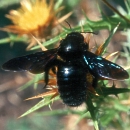 Three aculeates (Hymenoptera, Aculeata) are widespread
on the island in summer and are noticeable for their large size. The carpenter
bees (chiefly Xylocopa violacea) are
magnificent black bees that make a conspicuous hum as they fly fairly
ponderously from flower to flower. They are not known to be aggressive and very
rarely sting. The velvet wasp, Megascolia
maculata is one of the largest Hymenopterans in Europe and is a
beautiful insect with golden yellow bands across its dark brown abdomen. It is harmless to Man but, as they fly fast and are very big, they can
cause unfounded alarm. Hornets are also
Three aculeates (Hymenoptera, Aculeata) are widespread
on the island in summer and are noticeable for their large size. The carpenter
bees (chiefly Xylocopa violacea) are
magnificent black bees that make a conspicuous hum as they fly fairly
ponderously from flower to flower. They are not known to be aggressive and very
rarely sting. The velvet wasp, Megascolia
maculata is one of the largest Hymenopterans in Europe and is a
beautiful insect with golden yellow bands across its dark brown abdomen. It is harmless to Man but, as they fly fast and are very big, they can
cause unfounded alarm. Hornets are also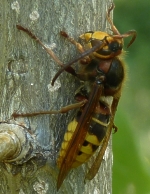 common in the lowlands and in mid-late summer can be seen patrolling most of the
island’s beaches or nesting in the old olive groves. Obviously hornets can be
very aggressive if their nest is disturbed but generally they ignore Man (unlike
many of the social wasps) and will fly up and down beaches looking for food
sources without paying any attention to holidaymakers. Two species, V. crabro
and V. orientalis, have been reported from Thásos. Recently
social waps have caused some problems on beaches in late summer, especially on
Golden Beach on the east coast. There are certainly good and bad years for
social wasps but if you are unlucky to visit when they are a nusiance then it is best
to avoid beaches with lots of tourists, particularly those with beachside
tavernas and other food outlets as these attract the wasps in the first place.
common in the lowlands and in mid-late summer can be seen patrolling most of the
island’s beaches or nesting in the old olive groves. Obviously hornets can be
very aggressive if their nest is disturbed but generally they ignore Man (unlike
many of the social wasps) and will fly up and down beaches looking for food
sources without paying any attention to holidaymakers. Two species, V. crabro
and V. orientalis, have been reported from Thásos. Recently
social waps have caused some problems on beaches in late summer, especially on
Golden Beach on the east coast. There are certainly good and bad years for
social wasps but if you are unlucky to visit when they are a nusiance then it is best
to avoid beaches with lots of tourists, particularly those with beachside
tavernas and other food outlets as these attract the wasps in the first place.
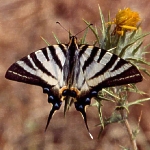 A striking butterfly
(Lepidoptera, Rhopalocera) that is quite common on Thásos through the summer is the scarce
swallowtail Iphiclides podalirius, which can be easily
approached as it sips nectar from tall flowers such as thistles. Similarly, the cardinal
Argynnis pandora (a relative of the silver-washed fritillary Argynnis
paphia), with its pink-flushed hindwings, is widespread on the island and
likely to be A striking butterfly
(Lepidoptera, Rhopalocera) that is quite common on Thásos through the summer is the scarce
swallowtail Iphiclides podalirius, which can be easily
approached as it sips nectar from tall flowers such as thistles. Similarly, the cardinal
Argynnis pandora (a relative of the silver-washed fritillary Argynnis
paphia), with its pink-flushed hindwings, is widespread on the island and
likely to be
 seen by many visitors. The giant
peacock
moth Saturnia pyri is nocturnal but may be seen at balcony
lights or street lamps in early summer. It resembles a large version of the
emperor moth Saturnia pavonia and is the biggest moth in Europe. With a wingspan
of 15 cms, it can be mistaken in flight as a bat. Hummingbird
hawkmoths Macroglossum stellatarum are commonly seen
throughout the summer. seen by many visitors. The giant
peacock
moth Saturnia pyri is nocturnal but may be seen at balcony
lights or street lamps in early summer. It resembles a large version of the
emperor moth Saturnia pavonia and is the biggest moth in Europe. With a wingspan
of 15 cms, it can be mistaken in flight as a bat. Hummingbird
hawkmoths Macroglossum stellatarum are commonly seen
throughout the summer.
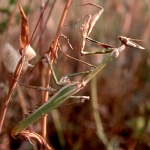 It is also at night that the preying mantis
Mantis religiosa (Dictyoptera: Mantodea) is
most often seen as adults frequently visit artificial lights, presumably
attracted by the presence of numerous moths. During the day they hide in the
undergrowth where they are well camouflaged. They are voracious predators of
other insects, including their own kind, but are harmless to Man. Several other
mantis species occur, including Empusa fasciata with its distinctive
pointed head. It is also at night that the preying mantis
Mantis religiosa (Dictyoptera: Mantodea) is
most often seen as adults frequently visit artificial lights, presumably
attracted by the presence of numerous moths. During the day they hide in the
undergrowth where they are well camouflaged. They are voracious predators of
other insects, including their own kind, but are harmless to Man. Several other
mantis species occur, including Empusa fasciata with its distinctive
pointed head.
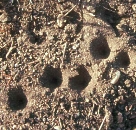 Equally
fearsome predators of small insects are the ant-lions
(Neuroptera, Myrmeleonidae). The larval
Equally
fearsome predators of small insects are the ant-lions
(Neuroptera, Myrmeleonidae). The larval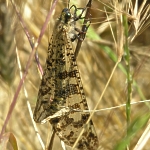 pits of Myrmeleon formicarius are
quite common in dry sandy soil around the island whilst the beautiful adults of Palpares
libelluloides can be seen flying weakly over grassy areas. pits of Myrmeleon formicarius are
quite common in dry sandy soil around the island whilst the beautiful adults of Palpares
libelluloides can be seen flying weakly over grassy areas.
Many fascinating insects are probably blissfully overlooked by the majority
of visitors, including representatives of two insect orders that are not native
to northern and western Europe. Both European species of termite
(Isoptera) occur on Thásos, tunnelling in the soil under stones or in dead
wood. Reticulitermes lucifugus is widespread in a variety of habitats but
I have only once seen Kalotermes flavicollis. Also found under stones are
the curious web-spinners (Embioptera), small
insects that inhabit silken tubes along which they can move at speed either
forwards or backwards. Haploembia solieri is probably the commonest
species encountered on Thásos but I’m not aware of anyone having attempted
the identification of these insects on the island.
Stones provide shelter from the heat of the day and hence many species from a
range of invertebrate Orders can be found by stone-turning (please replace them
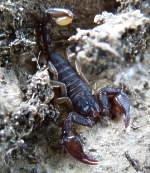 when you are finished). This can be a fascinating occupation but be aware that
you may well discover scorpions
(Scorpiones). 'Euscorpius sicanus', a small
species up to about 3cm long, is widespread and not uncommon under logs and
stones in old olive groves and woodland habitats. Fortunately it is harmless to
Man, but be cautious as Mesobuthus gibbosus (with longer, narrower pincers)
may also occur on the island and its sting is painful and potentially when you are finished). This can be a fascinating occupation but be aware that
you may well discover scorpions
(Scorpiones). 'Euscorpius sicanus', a small
species up to about 3cm long, is widespread and not uncommon under logs and
stones in old olive groves and woodland habitats. Fortunately it is harmless to
Man, but be cautious as Mesobuthus gibbosus (with longer, narrower pincers)
may also occur on the island and its sting is painful and potentially
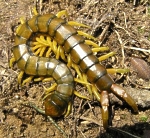 dangerous
to infants.
Also to be avoided are the grotesque olive green and red centipedes
Scolopendra (Chilopoda). They can grow up to about 10
cms long and have a painful and potentially dangerous bite if handled. By
contrast, the weird Scutigera coleoptrata occurs on walls where it can
move very fast and may occasionally be seen in apartments. It can be
distinguished by its 15 pairs of very long legs (not 100!), but despite its
alarming appearance it is harmless. dangerous
to infants.
Also to be avoided are the grotesque olive green and red centipedes
Scolopendra (Chilopoda). They can grow up to about 10
cms long and have a painful and potentially dangerous bite if handled. By
contrast, the weird Scutigera coleoptrata occurs on walls where it can
move very fast and may occasionally be seen in apartments. It can be
distinguished by its 15 pairs of very long legs (not 100!), but despite its
alarming appearance it is harmless.
True tarantulas, however, do apparently have a
poisonous bite for which exertion and copious sweating seem to be both symptom
and cure - one Greek remedy is for the victim to be "taken to the baker's
shop where he is placed in the oven and baked over a bundle of faggots for as
long as he can stand the heat" and similar 'cures' are reported from other
parts of the Mediterranean. There is some uncertainty whether or not tarantula
bites are poisonous but their retiring habits make it
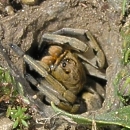 highly unlikely that any
visitor to Thásos would be bitten anyway. True
tarantulas (Aranea, Lycosidae) are wolf spiders and are not similar in appearance to the, so-called,
'tarantulas' of the tropics (or pet shops). On Thásos the species concerned
appears to be Geolycosa vultuosa, although there may be other species
involved. Their turreted burrows are not uncommon in bare friable soils alongside roads and
tracks in the middle of the island but the beautifully marked spiders are rarely
seen above ground. highly unlikely that any
visitor to Thásos would be bitten anyway. True
tarantulas (Aranea, Lycosidae) are wolf spiders and are not similar in appearance to the, so-called,
'tarantulas' of the tropics (or pet shops). On Thásos the species concerned
appears to be Geolycosa vultuosa, although there may be other species
involved. Their turreted burrows are not uncommon in bare friable soils alongside roads and
tracks in the middle of the island but the beautifully marked spiders are rarely
seen above ground.
In my experience mosquitoes are rarely a problem on Thásos, but a lot
depends on where you are staying, and whilst blackflies can be troublesome in
the uplands (wear long trousers as they tend to bite at calf level!) most ‘bugs’
on the island are inoffensive. Certain groups, such as the butterflies and
dragonflies, have been well-studied but much remains to be
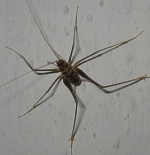 discovered and
documented about the majority of the thousands of species that live here. They
include endemics, such as the cave cricket Dolichopoda thasosensis
(Orthoptera, Rhaphidophoridae), the ground beetle Tapinopterus insulicola, or the subterranean snail Balcanodiscus difficilis
(Mollusca), and species new to science, such as the
water beetle Hydraena elisabethae (Coleoptera, Hydraenidae), are still
being discovered. I would be interested to hear from anyone with records
of invertebrates from Thásos and I can provide information on many more groups
than I have been able to produce web pages for to date. However, I cannot
pretend to be able to help with the identification of most species - accurately naming
invertebrates from this area of Europe is usually a long process involving the
assistance of a wide range of specialists. discovered and
documented about the majority of the thousands of species that live here. They
include endemics, such as the cave cricket Dolichopoda thasosensis
(Orthoptera, Rhaphidophoridae), the ground beetle Tapinopterus insulicola, or the subterranean snail Balcanodiscus difficilis
(Mollusca), and species new to science, such as the
water beetle Hydraena elisabethae (Coleoptera, Hydraenidae), are still
being discovered. I would be interested to hear from anyone with records
of invertebrates from Thásos and I can provide information on many more groups
than I have been able to produce web pages for to date. However, I cannot
pretend to be able to help with the identification of most species - accurately naming
invertebrates from this area of Europe is usually a long process involving the
assistance of a wide range of specialists.
|









